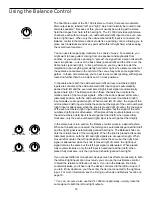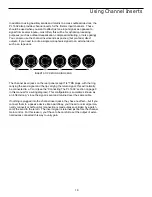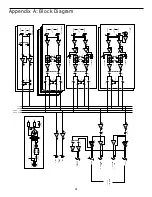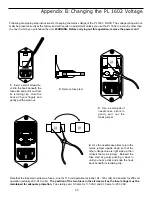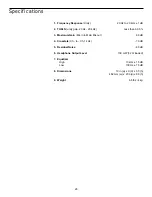
-40
+4
0
-10
TRIM
-40
+4
0
-10
TRIM
12
You’re now ready to establish the correct gain structure—the key to getting the
best performance from the PL 1602, or from any mixer, for that matter. This is a
simple procedure that ensures optimum input and output levels so that no
unnecessary noise (caused by too low a signal) or overload distortion (caused by
too high a signal) is created. Here’s a step-by-step description of how to do so:
a. With all connections made (as described on the previous page) but with the
power amplifier and PL 1602 off, start by setting the power amplifier volume to
minimum. On the PL 1602, turn all channel Level controls fully counterclockwise
(to their “
∞
” position), and then set the Left/Right faders to their “0” position.
b. If you have a microphone connected to channel 1 and/or channel 3, set their
rear panel Trim knobs to their fully counterclockwise (+4) position.
c. Set all channel EQ and Balance knobs as well as both Aux return Balance
knobs to their center detent “0” positions.
d. Set all channel Aux send knobs and both Aux return Level knobs to their fully
counterclockwise (“
∞
”) position.
e. Turn on all devices connected to channel line inputs and Aux returns and set
their output level controls to unity gain or, if there is no unity gain indicated on
their output control, to maximum. If you’ve got outboard effects processors con-
nected to Aux returns, make sure they are sending completely “wet” (processed)
signal, with no “dry” (unprocessed) signal mixed in.
f. Turn on the PL 1602’s rear-panel Power switch—the Power LED in the main
section will light up. Finally, turn on your power amplifier.
g. Play an instrument connected to one of the PL 1602’s line inputs* and, while
doing so, slowly raise the corresponding channel Level control to the 2 o’clock
“0” position. Then slowly raise the power amplifier volume until you reach the
level you want to hear. If the incoming signal sounds distorted, you may need to
lower the output level of the instrument, though this will rarely occur. Conversely,
if the signal is too low even with the output level of the instrument all the way up,
something’s definitely wrong: in all likelihood, the connecting audio cable is faulty
and should be replaced.
h. Repeat step (g) above for each instrument connected to the PL 1602 channel
line inputs.
i. If you have a microphone connected to channel 1 or channel 3, the procedure
for setting optimum microphone levels is as follows: sing or speak into the mic at
the level you expect to use in performance while slowly raising the Level control
for that channel to its 2 o’clock “0” position. Again, slowly raise the power ampli-
fier volume until you reach the level you want to hear. Then raise the rear panel
Trim control for that channel to a point at which you get a strong, clear signal that
doesn’t distort even at the highest singing or speaking levels. For best signal-to-
noise ratio, always keep the Trim control as high as possible short of distortion.
** If you’re using an instrument such as electric guitar or bass, we recommend
that you connect it to the PL 1602 with a direct injection box to ensure correct
impedance.
Setting the Correct Gain Structure
ON
OFF
POWER
Summary of Contents for PL1602
Page 1: ......


















